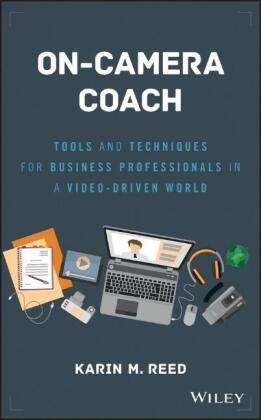Read more
The invaluable handbook for acing your on-camera appearance
On-Camera Coach is your personal coach for becoming great on camera. From Skype interviews and virtual conferences to shareholder presentations and television appearances, this book shows you how to master the art of on-camera presentation to deliver your message clearly, effectively, and with confidence. Fear of public speaking is common, but even the most seasoned speakers freeze in front of a single lens--being on camera demands an entirely new set of skills above and beyond the usual presentation to an audience you can actually see. It requires special attention to the way you move, the way you speak, and even the way you dress. This book provides the guidance and tools you need to ace it every time.
Video is powerful, and it is everywhere; corporate YouTube channels, webinars, virtual meetings, TedTalks, and more are increasingly turning the lens on those who typically remain behind the scenes. This relatively recent trend will continue to expand as media plays a larger role in business, and the ability to appear confident, authoritative, and polished is becoming a necessary job skill. This book shows you everything you need to know about being on camera, from preparation through presentation and beyond.
* Learn how to prepare for an on-camera appearance
* Tailor your presentation to on-camera demands
* Discover how the camera interprets wardrobe and body language
* Appear dynamic, confident, and engaged when the lens points your way
The lens captures everything--the awkward pauses, the nervous fidgets, poor posture, and every false start and mistake is captured for posterity. Is that the image you want to present? You want to get your message across and be heard; to do that, you must portray authority, energy, and confidence--even when you don't feel it. On-Camera Coach provides the expert instruction and insider secrets that help you make your message sing.
List of contents
Wiley & SAS Business Series ii
Preface xvii
Acknowledgments xix
Section One The Inescapable Reality--We All Have to Communicate through a Camera 1
Chapter 1 Why You Need to Read This Book 3
The Power and Pervasiveness of Video 5
The Decline of the Professional Spokesperson 6
The Global Communication Tool of Choice 7
Hiring by Skype 8
The Perils of Video 9
How Reading This Book Can Improve Your On-Camera Performance 9
What You Will Need 10
Topics to Be Discussed 10
Chapter Takeaways 11
Notes 11
Chapter 2 Why the Camera Changes Everything 13
My "Aha!" Moment 16
A Camera Changes Everything 17
No Immediate Feedback 17
Your Own Worst Critic 18
Recorded for Posterity 19
Unfamiliar Territory 20
The Archenemy of Performance Success: You 21
The Key to On-Camera Success: Authenticity 22
Chapter Takeaways 24
Section Two The MVPs of Performance Success 25
Chapter 3 M--Mental Mind-set: The Prep before the Performance 27
Reaching the Real Audience 28
Visualize the Viewer 30
Video Chat: Now You See Me, Now You Don't 30
Embrace Your Nervousness 32
Passion Play 33
Beware of Brain Cramps 33
The Bottom Line: It's Not about You 35
Chapter Takeaways 38
Note 39
Chapter 4 V--Vocal Variety: Pacing and Pausing with Purpose 41
The Musicality of Your Delivery--What's Your Range? 42
What Is Vocal Variety? 42
Natural versus On-Camera Inflection 43
Setting Your Pace with the Viewer in Mind 44
Finishing Your Thoughts 45
Using the Power of the Pause 45
Pause for You 45
Filler Words as Placeholders 47
Pause for Them 47
The Lowdown on Uptalk 49
The Most Common Uptalk Trouble Spot 50
Chapter Takeaways 54
Note 54
Chapter 5 P--Physical Factors: On-Camera Movement with Meaning 55
On-Camera Gesturing: An Out-of-Body Experience 56
Getting Familiar with Frame Size 58
Gestures for a Tight Shot 58
Gestures for a Medium Shot 58
Gestures for a Wide Shot 59
Gestures as a Retention Tool 60
The Role of Off-Camera Movement 61
Posture Pointers 61
Standing While on Camera 62
The Metronome Effect 62
Going for a Walk 62
Sitting While on Camera 63
Crossed Legs 64
Leaning In or Out 64
Step In to Start 65
Making Eye Contact When You Can't See Your Audience 66
Look Away 66
Performance Pitfalls: Eye Contact Errors 67
Vary Your Angle 68
Look Up 68
Chapter Takeaways 72
Notes 72
Section Three Ready to Wear . . . or Not 73
Chapter 6 Looking the Part--Wardrobe 101 75
Match Audience Expectations 77
Boring Is Best 78
Spin the Color Wheel 78
Special Consideration: Green-Screen Shoots 79
Solids: A Solid Choice 80
Putting on the Pounds 82
Dress Right for the Mic 82
Pack Placement 83
Microphone Placement 83
Jewelry Jukebox and Light Show 84
Your Fifth Appendage: A Smartphone 85
Additional Considerations for Men 85
Sock Style 86
The Uniform Look 87
To Button or Not to Button? 87
Chapter Takeaways 88
Notes 88
Chapter 7 Hair
About the author
Karin M. Reed is the CEO of Speaker Dynamics, a communications firm based in Raleigh, North Carolina. She has made a career out of communicating on camera as an award-winning broadcast journalist, spokesperson, and executive communications specialist. Karin has been a trusted trainer and consultant for organizations ranging from early-stage start-ups to Fortune 500companies. She empowers her clients, whether they come from the C-suiteor the sales force, to speak with ease to any audience on any platform. Her methodology is based on more than 20 years of personal presentation prowess and the understanding that the best speakers are steeped in authenticity.
Summary
The invaluable handbook for acing your on-camera appearance On-Camera Coach is your personal coach for becoming great on camera.

